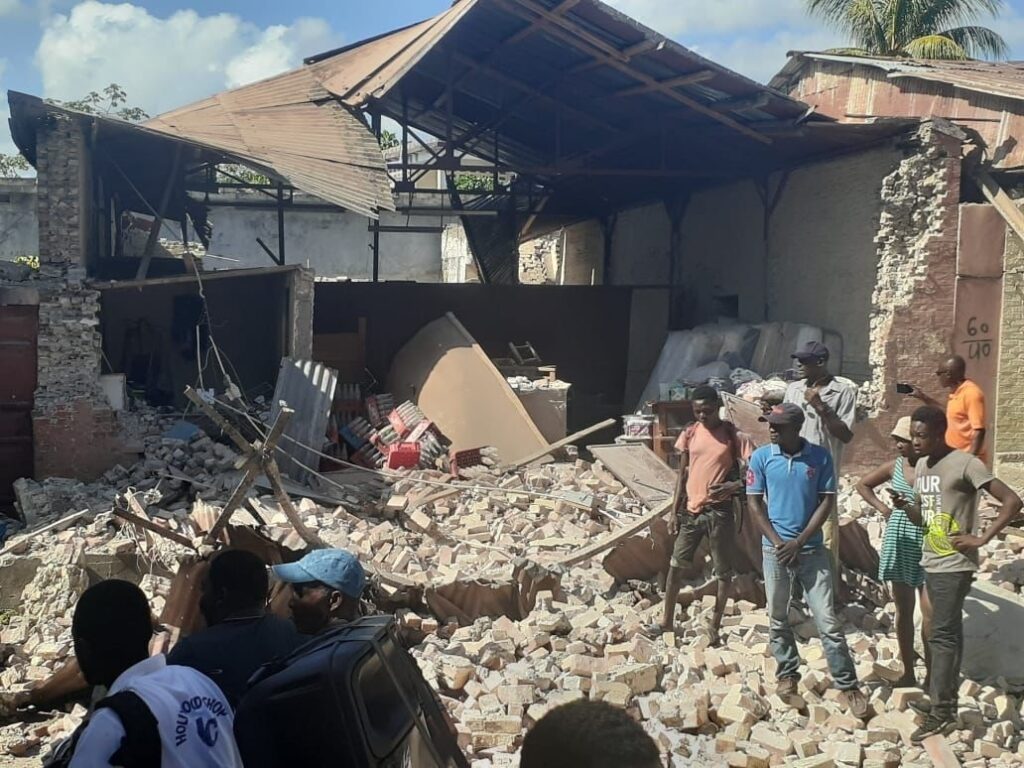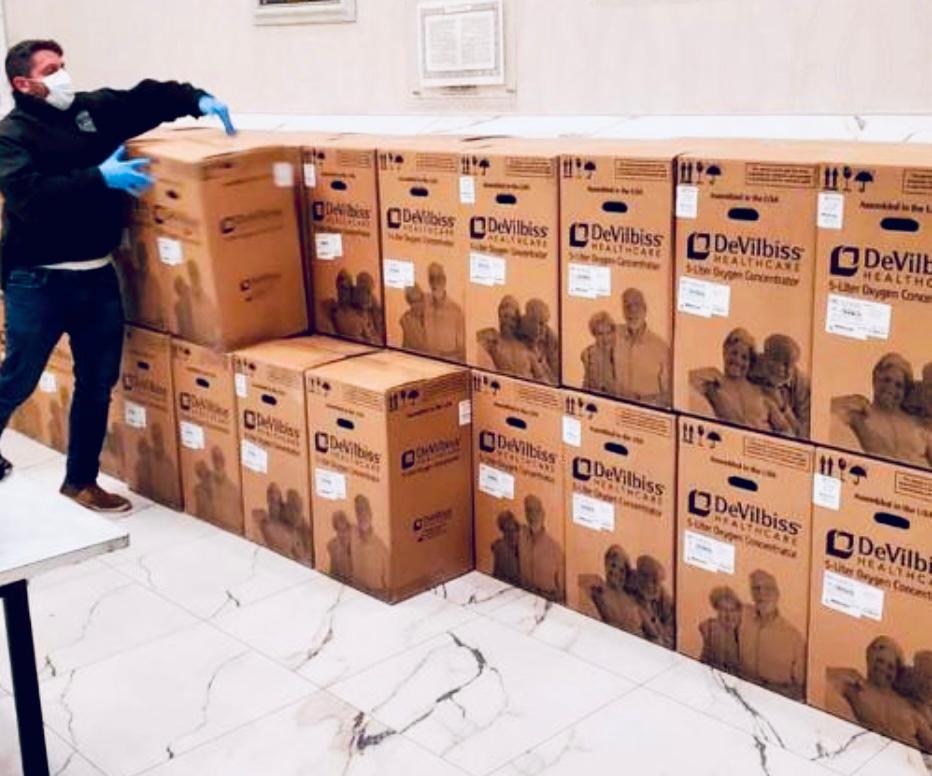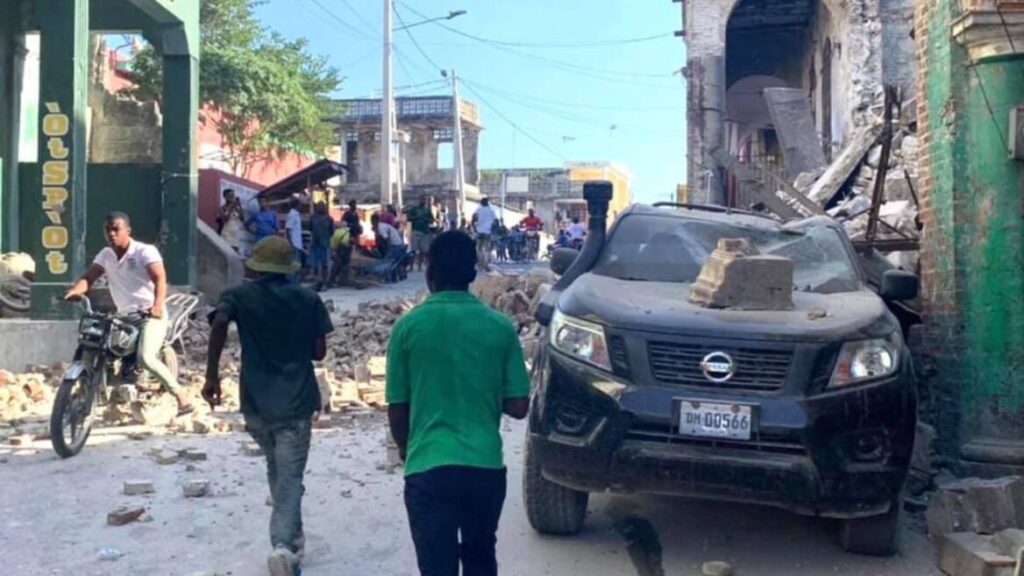Israeli humanitarian organization SmartAID has partnered with local responders and agencies in Haiti to aid the population following a devastating 7.2 magnitude earthquake that struck the country Saturday morning.
The Haitian government declared a state of emergency after the deadly quake collapsed buildings and historical cathedrals in southern and western parts of the country, killing at least 1,297 people, injuring more than 5,700, and destroying 13,694 homes, according to recent media reports.
The destruction comes just a little over a decade after the disastrous 2010 earthquake that killed some 300,000 people and displaced 1.5 million.

As part of its response, SmartAID teamed up with international aid group Third Wave Volunteers to send out small teams to assess areas affected by the earthquake, like Les Cayes, Camp Perrin, and Jeremie. Third Wave specializes in mobilizing medical and non-medical volunteers, aid, and general resilience after natural disasters.
Shachar Zahavi, SmartAID’s founding director, tells NoCamels that the earthquake destroyed and contaminated water supplies, creating an urgent need for safe and clean drinking water. In response, SmartAID will install new water units for fresh, clean drinking water, and solar-powered lighting for energy in some of the most hard-hit communities.
This is so affected families will be able to survive the first few weeks, Zahavi tells NoCamels.

Due to severe infrastructure damage and power outages in the area, SmartAID’s initial relief efforts will also focus on providing critical telecommunications to support the emergency responders and local groups providing aid.
In addition, the organization will distribute protective gear to health workers and first responders as COVID-19 is still spreading across the country, he explains.
“SmartAID is a proven leader in driving innovation and adapting new technologies to global emergency and disaster relief efforts. In Haiti, SmartAID’s first priority is to ensure safety and stability while empowering affected communities to get back on their feet. These have essentially become the basic needs of the 21st century,” he says.
Using tech to provide humanitarian aid
The emphasis on technology and logistics to provide disaster relief responses around the world is what defines SmartAID, the Israel-based NGO that works with local groups to provide humanitarian aid with creative, well-managed solutions.
When Hurricane Dorian struck the Bahamas in 2019, SmartAID sent a team to help with disaster relief. Joining with a local NGO, they built a solar-powered hub on Abaco Island which housed 30 aid workers, and helped set up telecommunications across the island.
When the bushfire disasters erupted in Australia in 2019 and 2020, SmartAID sent another team to Kangaroo Island to assist local farmers. Working with government services and a local NGO, the team helped the farmers quantify the damage to their property and minimize disease outbreaks among the livestock.
And when the COVID-19 crisis devastated India this past spring, SmartAID sought to provide resources and logistical support to the hardest-hit parts of the country. The nonprofit sent oxygen concentrators to many “hot zones” and worked with local organizations to combat misinformation about COVID-19 and the vaccine.
SEE ALSO: Israeli Organizations Send AID To India Amid Surge In COVID-19 Infections
SmartAID’s assistance in these areas is just a glimpse into the nonprofit’s work around the world since its founding in 2017.
“Our goal is to bring the tech world and the humanitarian world together,” he adds. While the idea may be broad, the work is done — and the impact is felt — at the local level,” he tells NoCamels.
“Recent decades have seen a dramatically accelerating pace in the development and adoption of new technologies by societies globally. This rapid technological change is changing the traditional way aid is being used in times of catastrophes and SmartAID is at the forefront of aligning and integrating technology with a humanitarian response,” Zahavi says.
Sign up for our free weekly newsletter
SubscribeIn India, Zahavi confirmed to NoCamels that SmartAID had worked with local partners to deliver 3,874 oxygen concentrators to medical facilities and rural hospitals in the region.

The nonprofit focused particularly on the needs of marginalized communities which “face the greatest risk since they are already struggling to meet their daily needs,” Zahavi said in a statement in June. “With and through our local partners we are able to reach out to some of the most poor and rural communities, as well as women, girls, and children who are at highest risk.”
SmartAID’s work in the country has gone beyond healthcare supplies, however. Together with local community members, the nonprofit is working to combat vaccine misinformation and sign individuals up to get inoculated through the Indian government system.
“It’s something we’re developing with them, and they’re leading the way,” Zahavi emphasizes NoCamels.
While SmartAID recently responded to other disasters, such as the condominium collapse in Surfside, Florida, much of its recent work has been related to the pandemic. Early on, when the novel coronavirus first hit the city of Wuhan, China, SmartAID partnered with DHL to airlift more than 35,000 face masks.
SmartAID’s work has expanded over the course of the pandemic. The nonprofit worked with local charities to provide personal protective equipment for the Rohingya refugee camp in Cox’s Bazar, Bangladesh. And when one local charity mentioned the need for solar lights at the refugee camp so doctors could work into the night, SmartAID made it happen.
Listening to and learning from local organizations is a large part of SmartAID’s mission. Rather than telling the residents of an affected area what to do, SmartAID always works with organizations on the ground. And this isn’t just a symbolic gesture: The technology SmartAID provides must work within the existing infrastructure there, and locals are the ones who know their home best.
“Something that I’ve seen in 25 years of work is that people know what they want, and more or less know how to figure it out,” Zahavi says. “You just need to give them the tools.”
SmartAID’s mission
Zahavi is not new to the humanitarian aid world. In fact, it was his own and his co-founders’ understanding of the space that encouraged them to start SmartAID, formerly known as iAID.
Zahavi has been involved in humanitarian aid work for more than 25 years, and has built five different nonprofits in that time. Before SmartAID, he founded and led IsraAID for 18 years. IsraAID also partners with local organizations to help those affected by disasters by providing aid and resources for recovery.
But, along with some fellow aid workers and individuals from the tech world, Zahavi felt there was a major gap to fill. In his experience, there were often unnecessary inefficiencies and logistical challenges in disaster relief, he tells NoCamels. Following the 2010 earthquake in Haiti, for example, very few foreign aid groups went into population centers because of false rumors of the onset of riots. Today, drones can survey cities and areas to determine how safe they are for aid workers.

And so, Zahavi and his partners decided to start SmartAID to answer those unmet needs. “We found that the humanitarian field was not leveraging the tech world enough to improve both the humanitarian response, as well as simplify work on the ground,” he explains.
Tech companies sometimes try to do more social justice-oriented work but don’t have the local knowledge to implement it effectively, Zahavi claims. SmartAID also hopes to bridge that gap and connect local organizations with new developments, rather than force unwanted technology onto those places.
With offices in Australia, the US, and Israel, the team aims to bring these worlds together. They have four key action areas that show a commitment to both short and long-term aid: crisis response, mid-term capacity building, long-term education and training, and future investment in technology.
SmartAid is also working on 10 of the 17 Global Goals for Sustainable Development that the United Nations created in 2015, ranging from promoting gender equality to providing affordable and clean energy, with an overarching mission to eradicate poverty worldwide.
“What we’re doing is a more holistic approach to help build this realm of how technology impacts humanitarian aid, especially in disasters,” Zahavi says.
Related posts

Editors’ & Readers’ Choice: 10 Favorite NoCamels Articles

Forward Facing: What Does The Future Hold For Israeli High-Tech?

Impact Innovation: Israeli Startups That Could Shape Our Future




Facebook comments